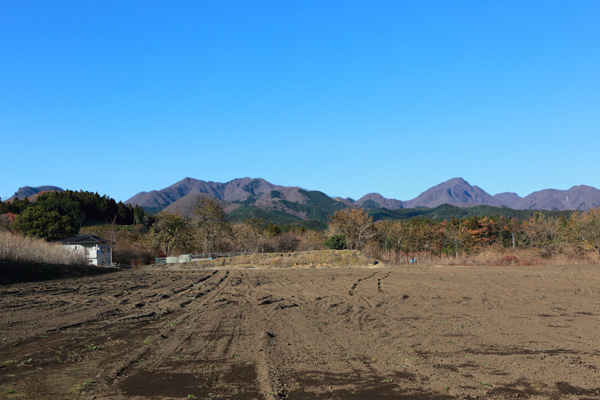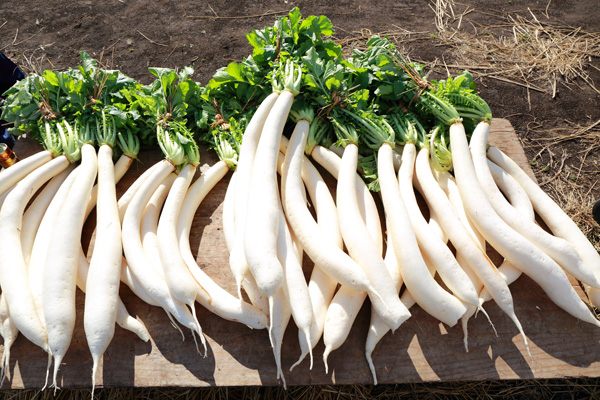White Curtains Swaying in the “Daikon Wind” from the Foothills

The daikons used for takuan pickles are over 50 cm long!

The Jumonji area of Takasaki is the region around what was known as Haruna Town before it merged. It lies in the Mt. Haruna foothills with soil rich in volcanic ash accumulated from Mt. Haruna. This soil provides excellent drainage, resulting in a long history of farming in the area. The area boasts many fruit orchards and farms, with pastoral scenery as far as the eye can see.
The harvest season for Jumonji Daikon is from November to December. The major daikon varieties are Hoshi-riso, Aki-masari, and Tsuke-hikari. These are all for takuan pickles, and these daikons grow to become over 50 centimeters long.

We visited the field growing Hoshi-riso, which is known for its soft texture and excellent quality. The farmers were working hard in the field and harvesting while pushing away the lush growth of daikon leaves that covered the soil.
Daikons are harvested with the utmost care. This is because the Hoshi-riso daikon variety tends to bend beneath the ground, curving under the weight of its own leaves during growth. Yanking out a Hoshi-riso daikon may possibly break it. For this reason, the farmers need to dig halfway down the roots to prevent these daikons from snapping. Harvesting daikons that weigh one to two kilograms one by one is extremely intensive labor.

“The standard aokubi-daikon (green-necked radish) can be easily pulled out from the ground. However, within all Jumonji daikon varieties, the Hoshi-riso tends to ‘curve’ the most. This makes harvesting more time and labor-consuming than other daikon varieties,”
says Hideo Gokan, the chairman of the Haruna/Jumonji Daikon Productive Association. He possesses a field in one corner of the area, and has grown 5,000 daikons this year.

After daikons are harvested, the washing process starts before the soil dries on the daikons. The daikons are gathered into a tank full of water and mud is scrubbed off by the brushes of a vegetable washing machine. As the daikons of this region tend to have irregular curves, the farmers need a special washing machine for this process. The washing process ends in 10 to 20 minutes, and the cleaned, pure-white daikons are gathered on a working table.
The “Daikon Winds” which creates quality dried daikons

The daikons on the working table are paired and have their leaves bound with straw. The straw knots are suspended upon rods to allow the daikons to hang and dry.
“The process of washing and hanging daikon to dry needs to be done one after another, right after harvest. That is why the harvest of Jumonji daikons is a race against time. The drying process is especially important, as the way a daikon is dried affects its flavor when made into takuan pickles,” says Gokan.

The area features a diverse lineup of drying spots such as the eaves of homes, beside cowsheds and in cedar and bamboo forests. The rows of daikons hung out to dry are often compared to curtains. This is a seasonal scene only found in the winter.
“The cold winds that blow down from Mt. Haruna and Mt. Akagi are perfect for drying daikons. Moisture evaporates, causing these daikons to become sweeter than plain raw daikon, making it delightful to eat as takuan pickles. The temperatures here are not too cold, so there is no worry of the daikons freezing. I think this area has the perfect environment for making dried daikons.”

It is said that some farmers call these winds the “Daikon Winds.” Local residents say that any windy and chilly days in this area are “good weather days.”
Gokan hangs his daikon harvest in a cedar forest located on a slightly elevated area with full access to the mountain winds. The cedar trees prevent direct sunlight and rain from reaching the daikons, making it the perfect location for drying.

If everything goes well, the dried daikons are shipped out in approximately two weeks. Gokan deliberates whether each daikon is ready with his own hands. A daikon is ready for shipment if it is completely dry and easily bends into a “U” shape.
Most of the dried daikons are processed into takuan pickles and sold at farmer’s markets or local supermarkets. They are often pickled in barrels along with rice bran, salt and sugar, and sold along withf the barrel. Many households in this area also make their own takuan pickles. The flavor of the pickles varies between each family, with some pickled with eggplant leaves for taste, or with turmeric for a stronger yellow hue.

The Jumonji daikons offer a fine and crisp texture, which is accentuated when made into takuan pickles. Biting into a homemade Jumonji takuan pickle offers a delightful crunch—a texture that cannot be found in standard takuan pickles. The Jumonji takuan pickles also follow the crunch with a sweetness and a slight bitter aftertaste. These pickles have an exquisite and profound flavor.
Handing down local flavors to the next generation

More than half of the Jumonji daikons are consumed locally as takuan pickles. Not many pickles are shipped out for distribution, as the process of harvesting to shipment is extremely time-consuming. The quantity of Jumonji daikons harvested is extremely scarce when compared to the common aokubi-daikon, which makes up of 80 to 90% of market shares.
In recent years, the amount of harvested Jumonji daikons have been decreasing due to the lack of successors of daikon farms. If this is not resolved, the local scenery and flavor of these daikons are in danger of being lost forever.
The Haruna/Jumonji Daikon Productive Association was launched in 2018 to resolve this current situation. Along with the association’s initiator, Hideo Gokan, approximately 30 local farmers have joined this organization.

“This does not mean that the Jumonji daikons are set to disappear in a few years, but the quicker something is done about this, the better. The first action for us to take is to spread the word about Jumonji daikons outside of this region. Doing so will expand the market and hopefully lead to more manufacturers who will harvest this daikon variety.”
The Association has high hopes for a younger member Akihiko Iino. It has been two years since he has taken part in the Jumonji daikon harvest as a side job to his main occupation. In November, Iino planned a harvest event and brought together farmers and consumers through Jumonji daikons.

“Local children and their families participated in the harvest event—a total of a dozen or more people. The children were very excited to see these daikons and their interesting shapes! The Jumonji daikon is a local specialty product and a local culture. I want to communicate the appeal of this vegetable to the next generation, which will carry on the daikon legacy.”
The Jumonji daikon has started to burst out of its local boundaries with these new developments. In the coming days, we may be hearing the distinctive “crunch!” of these daikon pickles at a table near you!











